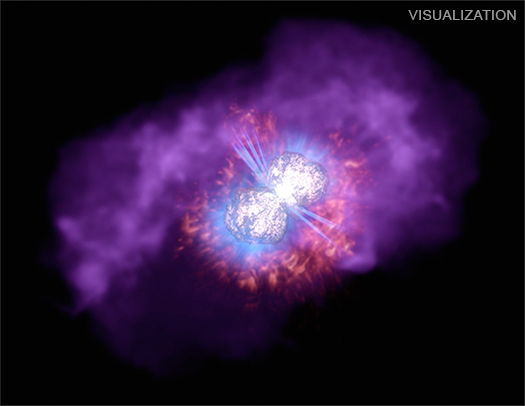For Release: January 25, 2022
NASA/STScI

Credit: NASA/ESA, J. Olmsted, D. Player, L. Hustak, A. Pagan, J. DePasquale, G. Bacon, F. Summers (STScI), R. Hurt (Caltech/IPAC)
Press Image, Caption, and Videos
A new astronomical visualization from NASA's Universe of Learning showcases the multiwavelength emissions (from infrared light through X-rays) and three-dimensional structures surrounding Eta Carinae, one of the most massive and eruptive stars in our galaxy. The video, "Eta Carinae: The Great Eruption of a Massive Star," is being released today on hubblesite.org and universe-of-learning.org.
Eta Carinae, or Eta Car, is famous for a brilliant and unusual outburst, called the "Great Eruption," observed in the 1840s. This briefly made it one of the brightest stars in the night sky, releasing almost as much visible light as a supernova explosion.
The star survived the outburst, and slowly faded away for the next five decades. The primary cause of this brightness change is a small nebula of gas and dust, called the Homunculus Nebula, that was expelled during the blast, and has blocked the light of the star.
Observations using NASA's Hubble Space Telescope and Chandra X-ray Observatory reveal the details in visible, ultraviolet, and X-ray light. Astronomers and artists at the Space Telescope Science Institute (STScI) in Baltimore, Maryland have developed three-dimensional models to represent the hourglass shape of the Homunculus and the clouds of glowing gas that encompass it. The result is a stunning tour of the nested emissions that brings the 2D images to 3D life.
"The team did such an amazing job representing the volumetric layers that viewers can immediately and intuitively comprehend the complex structure around Eta Car," said Frank Summers, principal visualization scientist at STScI and project lead. "We can not only tell the story of the Great Eruption, but also showcase the resulting nebula in 3D."
In addition, Eta Car is extremely bright at infrared wavelengths, and its radiation impacts the much larger Carina Nebula where it resides. Working with NASA's Spitzer Space Telescope observations, the team was able to place Eta Car in context of the dazzling infrared view of the star-forming region.
"Spitzer's infrared image lets us peer through the dust that obscures our view in visible light to reveal the intricate details and extent of the Carina Nebula around this brilliant star," commented Robert Hurt, lead visualization scientist at Caltech/IPAC and team member.
Extending the goals of NASA's Universe of Learning, the visualization assets promote learning beyond the video sequence. "We can take these models like the one for Eta Car and use them in 3D printing and augmented reality programs," noted Kim Arcand, visualization lead scientist at the Chandra X-ray Center in Cambridge, Massachusetts. "This means more people can put their hands on the data — literally and virtually — and this makes for better learning and engagement."
Eta Carinae is one of the most massive stars known. These exceptional stars are prone to outbursts during their lives. They will end their lives by collapsing into a black hole, probably accompanied by a supernova explosion. Eta Car is one of the nearest and best studied examples for learning about the energetic life and death of very massive stars.
Want to learn more? The visualization video and extensive related resources, which will include an upcoming Universe of Learning online live chat with Summers about the visualization, can be found at https://universeunplugged.ipac.caltech.edu/video/astroviz-etacar.
NASA's Universe of Learning is part of the NASA Science Activation program. The Science Activation program connects NASA science experts, real content and experiences, and community leaders in a way that activates minds and promotes deeper understanding of our world and beyond. Using its direct connection to the science and the experts behind the science, NASA's Universe of Learning provides resources and experiences that enable youth, families, and lifelong learners to explore fundamental questions in science, experience how science is done, and discover the universe for themselves.
NASA's Universe of Learning materials are based upon work supported by NASA under cooperative agreement award number NNX16AC65A to the Space Telescope Science Institute, working in partnership with Caltech/IPAC, Center for Astrophysics | Harvard & Smithsonian, and Jet Propulsion Laboratory.
Other materials about the findings are available at:
http://chandra.si.edu
For more Chandra images, multimedia and related materials, visit:
http://www.nasa.gov/chandra
Media contact:
Ray Villard
Space Telescope Science Institute, Baltimore, Maryland
410-338-4514
villard@stsci.edu
Science contact:
Frank Summers
Space Telescope Science Institute, Baltimore, Maryland


